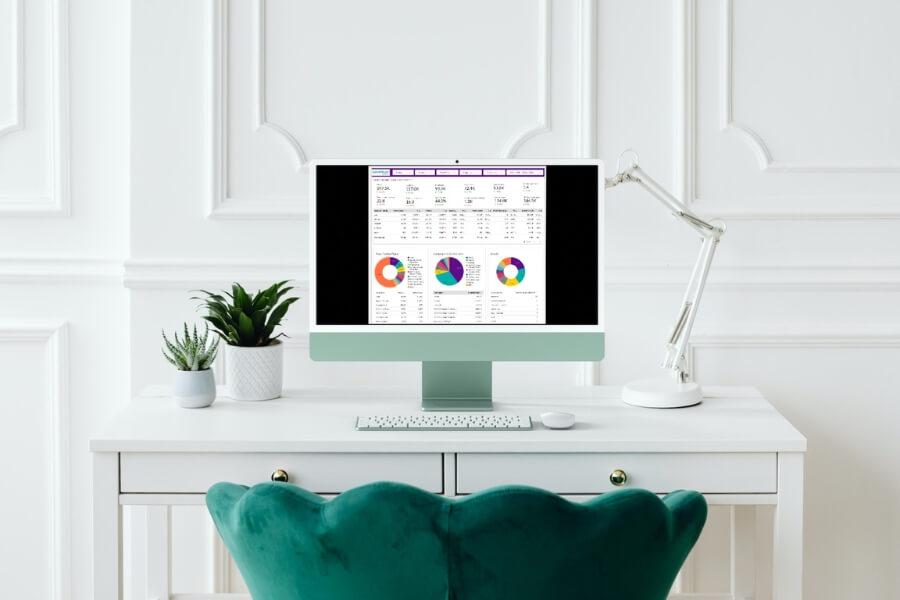We have seen it many times.
A small business owner, just starting out with a website asking – which website builder should I use? Wix or Squarespace?
Wix and Squarespace are two of the most popular options, powering more than half of websites built with a website builder.
On the surface, both seem to be doing the same thing, but if you take a closer look, you’ll see some very stark differences.
Our team is made up of digital marketing and web development professionals. This means our knowledge of what is needed from your website, to assist with your digital marketing efforts compliments each other.
And we are all about empowering our clients with the knowledge they need to grow the business.
With that in mind, we have listed some of the key things someone with a low digital literacy might take into consideration, when deciding between Squarespace vs Wix.
WIX vs Squarespace page builders – Which is easier for a beginner?
Wix promises to deliver a builder that makes things simple.
This means people who don’t know a lot about web design can launch websites in a few hours.
But here’s the catch – Wix also makes it very easy to build a poor performing website.
With Wix, you’re able to jump right in, throw together a web page and publish it. The page builder allows you to drag and drop in any element – whether it be a text block, an image or a button – to anywhere on the website, without giving it much thought.
However – the advanced customisation means it’s very easy to mess things up.
And here’s the kicker – when it comes to templates, they are not fully responsive. This means your website will not be automatically resized for mobile, a very important functionality issue.
This means you’ll have to build two versions of your website – one for desktop and one for mobile – which sort of takes away that promise of keeping things simple.
Looking at the Squarespace page builder – it does come with some limitations on how and where you can place your content. However, it is these constraints which allow all Squarespace templates to be fully responsive. In many cases, the modern templates in Squarespace just require you to switch out the content and you are on your way.
Putting it simply – if you’re building on Squarespace, your site design will adjust itself automatically so that it appears optimally on all devices. Not only does this make your site more accessible to a wider range of users, it provides big SEO benefits.
VERDICT: While many say the learning curve is steeper with Squarespace – I cannot agree with that sentiment. You will have to learn a new platform regardless of where you are building your website.
And also, because despite my experience building websites on several different platforms (including Squarespace, WordPress and Shopify) Wix had me stumped when it came to making simple changes like colours and fonts across the whole website in one click.
WIX vs Squarespace aesthetics – what looks good doesn’t necessarily perform well
Both Wix and Squarespace come with ready made templates for you to apply.
But before you go ahead and start building a website on any platform, you need to consider a few key factors.
- What are your business needs for your online presence?
- What kind of functionality do you want out of your website?
- How will it help with your sales funnels – and other marketing activities?
If it was ‘easy’ to build a website that works on every level – there wouldn’t be thousands of blog articles out there, about search engine optimisation (SEO), content structures and conversion optimisation.
The truth is, many companies do not spend enough time on their website brief. The reason is often because they don’t know what to ask about. (Or the web agency they’re working with doesn’t take the time to ask the right questions.)
This isn’t really your fault! Business owners shouldn’t necessarily know what questions to ask. Your business is your speciality – you should be able to trust your web developer to ask the right questions.
Here are some important ones to start you off:
- How should your content be structured?
- What image sizes should I be uploading?
- What page titles will you use?
- What will be the consistent header text for each page?
- What will your calls to action be?
- What will appear in search engine results?
Another all important question – have you implemented some kind of online tracking?
You should make sure to set up the essential Google tools to get insights from your website. These will let you know how it’s performing, and this may drive your marketing decisions.
Believe it or not, we have seen expensive websites set up without Google Analytics – a fundamental oversight you really shouldn’t get when spending thousands of dollars.
VERDICT: Whether it’s Wix or Squarespace, your brief is everything – and you need a platform that can help you fulfil your website goals.
We have had people come to us after spending $100 on their website, with some random DIY’er or an overseas company.
While they saved money on the site build – how much business has that ‘cheap’ website cost them? It probably turns out the website has cost them thousands in lost business.
This is why it shouldn’t be ‘easy’ to build a website. What looks good doesn’t necessarily perform well.
I also found the templates inside Squarespace to be more modern than in WIX, meaning you don’t have to redesign your website in a few years again to keep up with the times.
WIX vs Squarespace – Complexities
It must be said – WIX hides complexities.
While this suits some people – hiding complexities in website development is not necessarily a good thing. Wix makes it easy to design websites like brochures – and they’re not. And it’s important to remember – what you are seeing is not what Google is seeing.
Although Google does take user experience into account, it’s mostly around content and mobile friendliness.
One of the most basic elements Google cares about are how your page titles are structured and what they tell users about the page. Yet for a few Wix websites I’ve seen, there has been no attention paid to this – despite Wix supporting SEO settings for pages.
Unfortunately, Google doesn’t really care if your button looks nice, or your image is stunning. By hiding these complexities, it makes it very easy to feel really proud of your new website, shouting about how wonderful it is to the world!
Well – you better keep shouting – as that may end up being the best way to get your website found.
Because even if you’re a novice, you need to be across the trickier bits that make up your web presence. We’re talking about things like SEO, off site business listings, reviews and more.
Your website only makes up one facet of your digital ecosystem – there’s backlinks, business listings, social media, email marketing and your website.
Without all of these important elements, you may not get found by your customers. Which means unfortunately, your pretty Wix website will fall short of the mark.
VERDICT: I’ve seen briefs and quotes that don’t reflect even the most basic functionality a company needs, and they often treat SEO as an ‘optional extra’.
It is not. It’s essential and often implementing simple steps will make a huge difference to your visibility.
Just to clarify – I am not saying you can’t optimise WIX for SEO! What I am saying is, you need to know what you are doing.
Because making a pretty website is great – but that doesn’t mean it’s going to get found and work for you. Every serious web developer will say the same thing if they know what they are talking about.
If you already have an existing SEO strategy, then we have put together a handy SEO Maintenance Guide for you to access. We believe this resource will be an important tool for your business. It is a way for you to stay on top of your game – and continue to grow.
WIX vs Squarespace – Price
Wix is a very attractive initial platform – as the base offering is free.
It’s a very effective sales technique that definitely gets customers in the door. Mailchimp uses a similar technique – but then, Mailchimp doesn’t allow you access to automated email sequences in their base offering. (An essential part of email marketing.)
So here’s the deal with the free plans. You will have Wix branding on your site, and the little icon shown in the browser bar will be a Wix logo.
You also can’t add in Google Analytics tracking, Google Remarketing and Facebook pixels until you get onto a premium plan. (Another essential from a digital marketing perspective.)
In addition to this, regular pageview tracking does not work on WIX – with Google Analytics and Google Tag Manager – meaning you can’t track people’s visits to different pages to your website. This is because WIX websites are coded as single page applications to load content dynamically, while not actually changing the destination URLs. The workarounds are there, but they take some time and knowledge to implement when it should just work out of the box – like it does with Squarespace.
It’s important to note – premium plans start at a mere $10 USD or so per month so it’s not expensive by any means. The expenses come in when you start adding functionality.
Wix has an ‘app store’ so you can choose which apps to use. There are loads of apps to choose from and many start with a ‘freemium’ offering with more functionality provided at a price. So, head back to that website brief and factor in what you want into your costs.
Squarespace on the other hand is offering an all in one solution for the same monthly fee – so you know exactly what you are getting with no nasty surprises.
VERDICT: The largest cost of using Wix for many people is a hidden one. It’s the cost of websites built by users who may not know what makes a website really work, therefore it doesn’t get found, or it doesn’t function well.
That lack of functionality is probably costing you business.
So why do we prefer Squarespace?
If you’ve been paying attention – you’ll have noticed we lean towards Squarespace.
But it’s not as simple as that. You will need to work out the functionality you need for your business. You’ll also need some basic SEO knowledge, to build a functioning and searchable website that benefits your business – for both WIX and Squarespace.
But with Squarespace, your templates are automatically responsive to any size devices. The user interface is a lot cleaner and therefore simpler to navigate.
Squarespace is also a lot easier in terms of editing the overall site aesthetic. You can change the font, color, spacing for different types of blocks very easily, so you know that your site is going to be uniform in look. Yes, this is a lot more limiting by design, but that’s not always a bad thing. It also makes site building way faster. What takes 2-3 weeks in Wix, we can push out in 2-3 days in Squarespace.
There are no hidden costs and no limitations on how you can track visits to your website.
The templates in Squarespace are a lot more design-y and modern looking compared to WIX and it is easy to manage in the long term. When you decide to change your template, your content doesn’t delete like it does with WIX. This extra flexibility is already worth it in the long term.
Squarespace chat support is in my opinion way ahead of WIX’s phone support (via callback) that wasn’t working in Australia when I needed it.
The website load speeds are also on average 4 times faster than WIX – this is paramount to capture people’s interest during our short attention spans.
If you still aren’t sure what platform is best for your business, get in touch with us for a free 20 minute discovery session and let us help you get on the right track.



